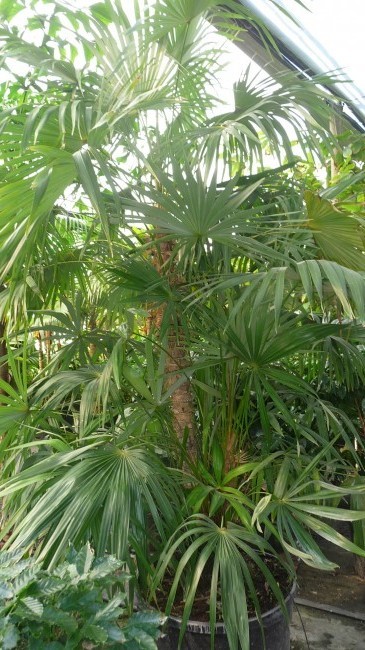Zombie palm
(Zombia antillarum)

Description
Zombia antillarum, commonly known as the zombie palm, is a species of palm tree and the only member of the genus Zombia. It is endemic to the island of Hispaniola (both the Dominican Republic and Haiti) in the Greater Antilles. Usually found in dry, hilly areas of northern and southern Haiti and the northwest of the Dominican Republic, Z. antillarum is a relatively short fan palm with clustered stems and a very distinctive appearance caused by its persistent spiny leaf sheaths. Threatened by habitat destruction in Haiti, Z. antillarum is a popular ornamental species due to its distinctive appearance, low maintenance requirements and salt tolerance. Zombia antillarum is a small palm which grows in dense, multi-stemmed clumps with stems up to 3 metres (10 ft) tall and 5 centimetres (2 in) in diameter. Individuals bear nine to 12 fan-shaped (or palmate) leaves which are greyish-white on the lower surface. The leaf sheaths remain attached to the stem after the leaf drops off. The intervening tissue gradually degrades, and the woody vascular tissue splits, forming the spines which are characteristic of the species. The inflorescence, which is shorter than the leaves, bears bisexual flowers with 9–12 stamens and a single carpel. Fruit are white in colour (although orange-fruited individuals are also known to exist), oblong or pear-shaped, 1.5–2 cm (0.6–0.8 in) in diameter and bear a single seed. The flowers and fruit are borne among the leaves due to the fact that the inflorescences are shorter than the leaves. Trees can produce 5000 seeds per year, predominantly in July and August. The species is believed to be wind pollinated. Zombia is a monotypic genus—it includes only one species, Z. antillarum. The earliest description of the species is found in the work of French physician and botanist Michel Étienne Descourtilz. In 1821 he placed it in the genus Chamaerops as C. antillarum. Italian naturalist Odoardo Beccari independently described the species in 1908, placing it in the genus Coccothrinax (as C. anomala). Recognising that it was distinct enough to be placed in its own genus, American botanist Liberty Hyde Bailey erected the genus Zombia in 1931 to accommodate the species that Descourtilz had described. This generated the combination Z. antillarum. In selecting a name for the genus, Bailey noted that
Taxonomic tree:







